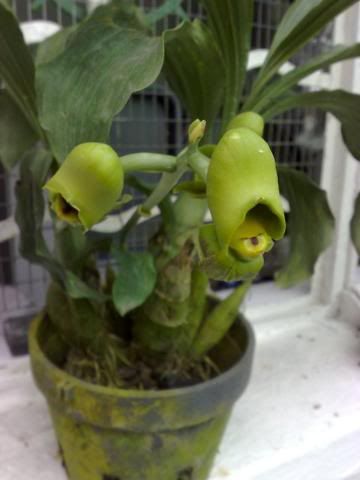

 I've had this Catasetum for quite a few years now and every time it begins to bloom, I would always wonder what "gender" of flowers it would produce.
I've had this Catasetum for quite a few years now and every time it begins to bloom, I would always wonder what "gender" of flowers it would produce. Catasetum, abbreviated as Ctsm in horticultural trade, is a genus of the Orchid family (Orchidaceae), subfamily Epidendroideae, tribe Cymbidieae, subtribe Catasetinae, with 166 species. Species of the genus Catasetum occur from Mexico to tropical America, with the majority in Brazil.
They have thick, cigar-shaped pseudobulbs which are clustered. The leaves are pleated in the upper part and deciduous. The pseudobulbs become spiny after the leaves have dropped. The inflorescence is borne on the basis. It consists of very fleshy flowers that are unisexual, which is exceptional for orchids. Catasetum have sexually dimorphic flowers; that is, male and female flowers are distinctly different in shape and color. The colorful male and yellowish-green female flowers are typically situated on different plants. Which type of flower a plant produces is determined by the conditions under which it grows. There are rare cases in which a single plant in intermediate conditions will produce both male and female flowers. These flowers are markedly different in size and color. At first, taxonomists even thought they were dealing with different species.
The male flowers have a remarkable technique for the ejection of the pollinia.
No comments:
Post a Comment